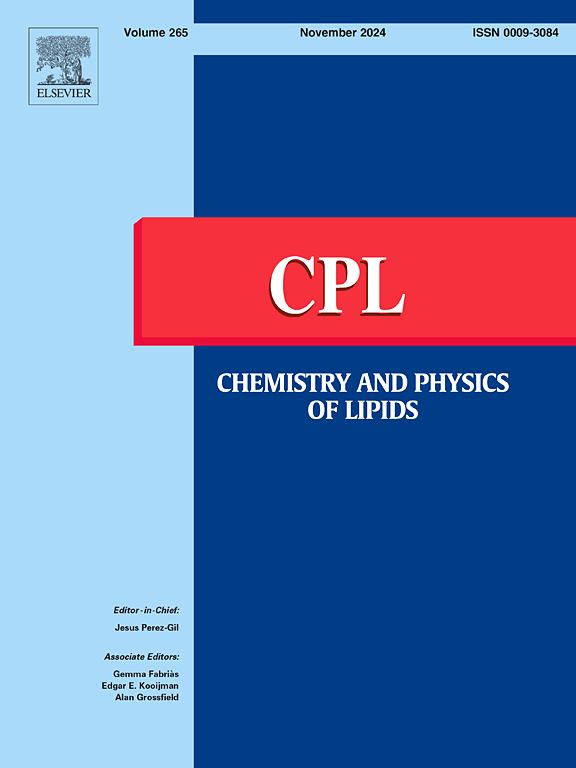Tucumã (Astrocaryum vulgare Mart.) oil-composed nanostructured lipid carriers for topical administration: Optimization by 22 experimental factorial design and stability assessment
IF 2.8
3区 生物学
Q2 BIOCHEMISTRY & MOLECULAR BIOLOGY
引用次数: 0
Abstract
The selection of lipids and their ratios play a critical role in determining drug loading capacity and the structural properties of nanostructured lipid carriers (NLCs), directly impacting their stability. Among liquid lipids, vegetable oils have been explored both as active pharmaceutical ingredients (APIs) and as excipients in NLCs intended for topical use. The pulp oil of Tucumã, derived from Brazilian biodiversity, is known for its anti-inflammatory and antioxidant properties, attributed to its high content of carotenoids. This study focused on evaluating the compatibility of Tucumã oil with various solid lipids (SLs) commonly used in NLC production, developing an optimized NLC formulation containing this oil, and monitoring its stability over a 28-days’ period. Lipid screening was performed to assess the compatibility of Tucumã oil with a series of SLs, followed by preliminary formulations to determine the type of SL and surfactant for the experimental design. A 22 experimental factorial design was used to understand and identify the significant effects and interactions of lipid phase and surfactant concentrations on Tucumã oil-loaded NLCs, and the stability of the optimized formulation was monitored by determining the mean particle size (z-Ave), polydispersity index (PI), zeta potential (ZP), and recrystallization index (RI%) over 28 days. Compritol® was identified as the most suitable SL, resulting in round shaped NLCs with z-Ave of 309 nm, PI of 0.23 and high ZP (−25.5 mV). The RI% was shown to be influenced by the storage time and temperature. The optimal formulation contained 8 % of lipid phase (at a 20:80 ratio of oil to SL) and 3 % of Tween® 80 as surfactant, showing stability at 5ºC, 25ºC and 40ºC. The experimental factorial design revealed a positive effect of surfactant concentration on z-Ave and PI, with no significant impact on ZP. Over time, NLCs exhibited a gradual color loss (becoming whiter), with no other signs of instability. These findings support the potential use of Tucumã oil for producing stable NLCs suitable for topical delivery.
外用给药的astrocaryvulgare M.油组成的纳米结构脂质载体:22因子设计优化和半固体配方的开发。
脂质及其比例的选择对纳米结构脂质载体(nlc)的载药能力和结构特性起着至关重要的作用,直接影响其稳定性。在液体脂类中,植物油已被探索作为活性药物成分(api)和外用nlc的赋形剂。Tucumã的果肉油来源于巴西的生物多样性,因其高含量的类黄酮和类胡萝卜素而具有抗炎和抗氧化特性。本研究的重点是评估Tucumã油与NLC生产中常用的各种固体脂类(SLs)的相容性,开发含该油的优化NLC配方,并监测其在28天内的稳定性。进行脂质筛选以评估SL的相容性,然后进行中试配方以确定SL和表面活性剂的类型和浓度范围,以进行实验设计。采用22因子设计来了解和确定脂质和表面活性剂浓度对Tucumã载油NLC的显著影响和相互作用,并通过测定平均粒径(z-Ave)、多分散性指数(PI)、ζ电位(ZP)和再结晶指数(RI%)来监测优化后配方的稳定性。Compritol®被确定为最合适的SL,形成圆形NLC, z-Ave为309nm, PI为0.23,ZP高(-25.5mV)。RI%受贮藏时间和温度的影响。最佳配方含有8%的总脂相(油与SL的比例为20:80)和3%的Tween®80作为表面活性剂,在5ºC, 25ºC和40ºC下具有稳定性。实验设计表明,表面活性剂浓度对z-Ave和PI有正影响,对ZP无显著影响。随着时间的推移,NLCs逐渐失去颜色(变白),没有其他不稳定的迹象。这些发现支持Tucumã油用于生产适合局部递送的稳定NLC的潜在用途。
本文章由计算机程序翻译,如有差异,请以英文原文为准。
求助全文
约1分钟内获得全文
求助全文
来源期刊

Chemistry and Physics of Lipids
生物-生化与分子生物学
CiteScore
7.60
自引率
2.90%
发文量
50
审稿时长
40 days
期刊介绍:
Chemistry and Physics of Lipids publishes research papers and review articles on chemical and physical aspects of lipids with primary emphasis on the relationship of these properties to biological functions and to biomedical applications.
Accordingly, the journal covers: advances in synthetic and analytical lipid methodology; mass-spectrometry of lipids; chemical and physical characterisation of isolated structures; thermodynamics, phase behaviour, topology and dynamics of lipid assemblies; physicochemical studies into lipid-lipid and lipid-protein interactions in lipoproteins and in natural and model membranes; movement of lipids within, across and between membranes; intracellular lipid transfer; structure-function relationships and the nature of lipid-derived second messengers; chemical, physical and functional alterations of lipids induced by free radicals; enzymatic and non-enzymatic mechanisms of lipid peroxidation in cells, tissues, biofluids; oxidative lipidomics; and the role of lipids in the regulation of membrane-dependent biological processes.
 求助内容:
求助内容: 应助结果提醒方式:
应助结果提醒方式:


